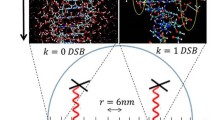Abstract
Radiotherapy is a comprehensive method, in which the main factor that determines success in clinical radiotherapy is radiation dose. It is necessary to make the most of mathematical theories to investigate the complicated mechanisms how P53-dependent regulation pathways govern cell survival and apoptosis at molecular level. In this work, we develop an integrated method for modeling Tumor Radiotherapy System (TRS) based on Kinetic Theory of Active Particle (KTAP) and Gene-Environment Network (GEN), and then explore the dynamics of integrated TRS through correlated subsystems, and inner mechanism of cell fate decision under radiotherapy. The inner mechanisms of radiotherapy are investigated at both molecular and systematic levels, including the stochastic kinetics of DNA damage generation and repair, switch-like Ataxia Telangiectasia Mutated (ATM) activation, oscillation of P53-Mouse Mouble Minute 2 homolog (MDM2) negative feedback loop, and outcome of tumor cell degradation and genome stability under radiotherapy.
Access this chapter
Tax calculation will be finalised at checkout
Purchases are for personal use only
Preview
Unable to display preview. Download preview PDF.
Similar content being viewed by others
References
Perez, C., Brady, L.: Principles and practice of radiation oncology. Journal of Pediatric Hematology/Oncology 21, 560 (1999)
Karlsson, M., Weber, W.: Therapeutic synthetic gene networks. Current Opinion in Biotechnology 23, 703–711 (2012)
Zhang, X.P., Liu, F., Wang, W.: Two-phase dynamics of p53 in the DNA damage response. Proceedings of the National Academy of Sciences 108, 8990–8995 (2011)
Kim, J., Lee, S.-D., Chang, B., Jin, D.-H., Jung, S.-I., et al.: Enhanced antitumor activity of vitamin C via p53 in cancer cells. Free Radical Biology and Medicine 53, 1607–1615 (2012)
Bellomo, N., Forni, G.: Looking for new paradigms towards a biological-mathematical theory of complex multicellular systems. Mathematical Models and Methods in Applied Sciences 16, 1001–1029 (2006)
Bellouquid, A., Delitala, M.: Mathematical modeling of complex biological systems: a kinetic theory approach. Springer (2006)
Caspi, A., Moffitt, T.E.: Gene–environment interactions in psychiatry: joining forces with neuroscience. Nature Reviews Neuroscience 7, 583–590 (2006)
Cercignani, C., Gabetta, E.: Transport Phenomena and Kinetic Theory. Springer (2007)
Bellomo, N., Delitala, M.: From the mathematical kinetic, and stochastic game theory to modelling mutations, onset, progression and immune competition of cancer cells. Physics of Life Reviews 5, 183–206 (2008)
Bellomo, N., Forni, G.: Complex multicellular systems and immune competition: New paradigms looking for a mathematical theory. Current Topics in Developmental Biology 81, 485–502 (2008)
Bertotti, M.L., Delitala, M.: Conservation laws and asymptotic behavior of a model of social dynamics. Nonlinear Analysis: Real World Applications 9, 183–196 (2008)
Brazzoli, I.: From the discrete kinetic theory to modelling open systems of active particles. Applied Mathematics Letters 21, 155–160 (2008)
De Angelis, E., Lods, B.: On the kinetic theory for active particles: A model for tumor–immune system competition. Mathematical and Computer Modelling 47, 196–209 (2008)
Qi, J., Ding, Y., Zhu, Y., Wu, Y.: Kinetic theory approach to modeling of cellular repair mechanisms under genome stress. PloS one. 6, e22228 (2011)
Yu, K., Wacholder, S., Wheeler, W., Wang, Z., Caporaso, N., et al.: A Flexible Bayesian Model for Studying Gene–Environment Interaction. PLoS Genetics 8, e1002482 (2012)
Cuddihy, A., Bristow, R.: The p53 protein family and radiation sensitivity: Yes or no? Cancer and Metastasis Reviews 23, 237–257 (2004)
Ribeiro, D., Pinto, J.: An integrated network-based mechanistic model for tumor growth dynamics under drug administration. Computers in Biology and Medicine 39, 368–384 (2009)
Zhang, X., Liu, F., Wang, W.: Regulation of the DNA damage response by p53 cofactors. Biophysical Journal 102, 2251–2260 (2012)
Bertotti, M.L., Delitala, M.: From discrete kinetic and stochastic game theory to modelling complex systems in applied sciences. Mathematical Models and Methods in Applied Sciences 14, 1061–1084 (2004)
Bellomo, N.: Modeling complex living systems: a kinetic theory and stochastic game approach. Springer (2008)
Deutsch, A., Dormann, S.: Cellular automaton modeling of biological pattern formation. University of Bielefeld, Germany Birkhäuser, Boston (2004)
Ma, L., Wagner, J., Rice, J.J., Hu, W., Levine, A.J., et al.: A plausible model for the digital response of p53 to DNA damage. Proceedings of the National Academy of Sciences of the United States of America 102, 14266–14271 (2005)
Author information
Authors and Affiliations
Editor information
Editors and Affiliations
Rights and permissions
Copyright information
© 2014 Springer-Verlag Berlin Heidelberg
About this paper
Cite this paper
Qi, JP., Qi, J., Pu, F., Zhu, Y. (2014). A Kinetic Modeling for Radiotherapy Mechanisms with Gene-Environment Network (GEN) Framework. In: Ma, S., Jia, L., Li, X., Wang, L., Zhou, H., Sun, X. (eds) Life System Modeling and Simulation. ICSEE LSMS 2014 2014. Communications in Computer and Information Science, vol 461. Springer, Berlin, Heidelberg. https://doi.org/10.1007/978-3-662-45283-7_30
Download citation
DOI: https://doi.org/10.1007/978-3-662-45283-7_30
Publisher Name: Springer, Berlin, Heidelberg
Print ISBN: 978-3-662-45282-0
Online ISBN: 978-3-662-45283-7
eBook Packages: Computer ScienceComputer Science (R0)




